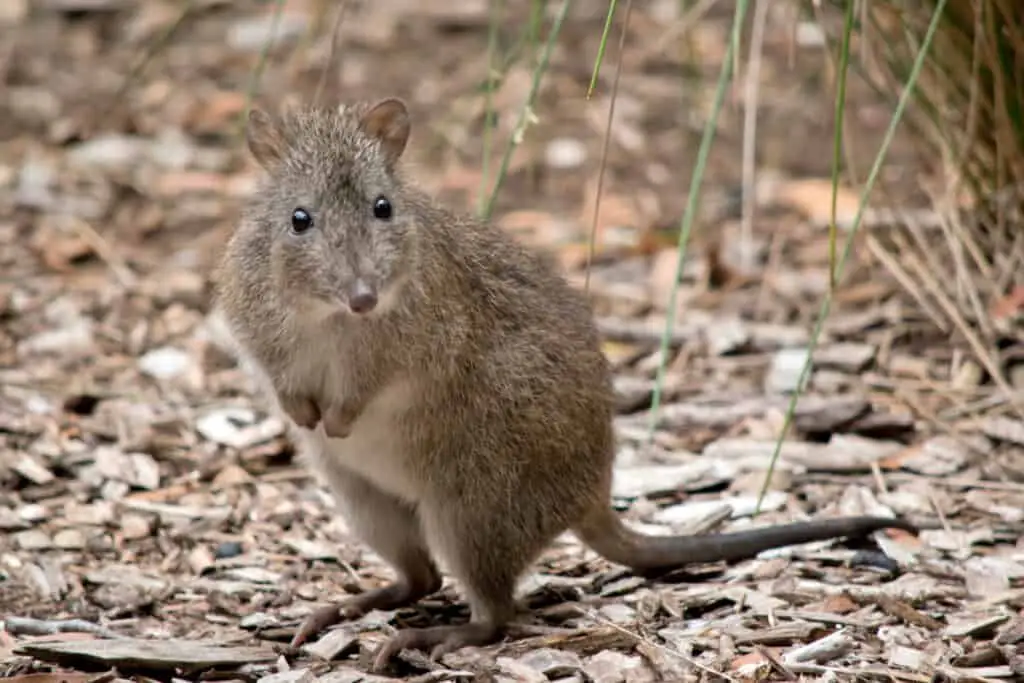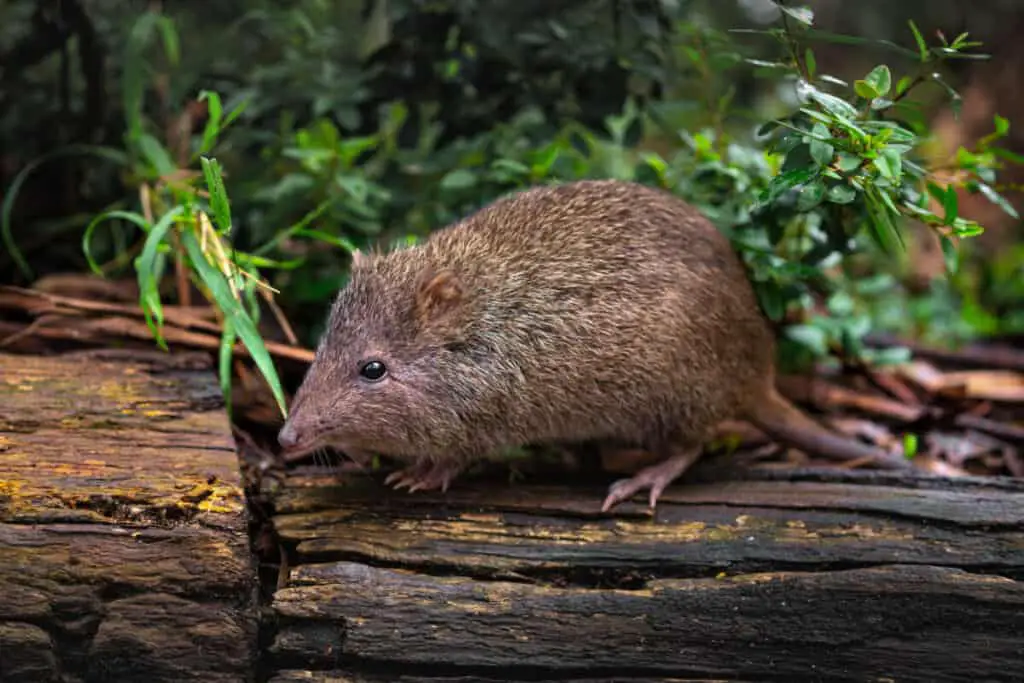The Potoroo is a small marsupial that belongs to the family Potoroidae. They are found only in Australia, inhabiting mainly forested areas and heathlands.
There are four known species of potoroo: Long-footed Potoroo (Potorous longipes), Broad-faced Potoroo (Potorous platyops), Gilbert’s Potoroo (Potorous gilbertii), and the endangered Bettong or Woylie (Bettongia penicillata).
Despite their small size, potoroos play an important role in their ecosystem as seed dispersers and insect predators. Their diet consists mostly of fungi, insects, seeds, and roots.
The nocturnal nature of these animals makes them difficult to spot in the wild; however, due to habitat destruction and predation by introduced predators such as foxes and feral cats, many populations have significantly declined over recent years.
As such, conservation efforts have been put in place to protect these unique creatures from extinction.

The Family Potoroidae
The Family Potoroidae, commonly known as the rat-kangaroos or bettongs, are small marsupials that inhabit Australia. These creatures have a unique appearance compared to other kangaroo species due to their small size and rodent-like features. The name ‘rat-kangaroo’ is derived from their physical characteristics which resemble both rats and kangaroos.
Behavioral patterns of the Potoroidae family revolve around nocturnal activities such as foraging for food and socializing with members of their group. They prefer to live in dense vegetation areas where they can easily hide from predators during daylight hours.
In terms of reproduction, female potoroos have a short gestation period, approximately 3-4 weeks, before giving birth to underdeveloped young who climb into her pouch until fully developed. This reproductive cycle allows females to produce multiple litters per year resulting in rapid population growth within specific habitats.
Habitat And Range
The Family Potoroidae, of which the potoroo is a member, consists of small marsupials that are native to Australia. These creatures are characterized by their unique hopping gait and long tails. Potoroos specifically belong to the genus Potorous and can be further classified into four species: the Long-footed potoroo, Long-nosed potoroo, Gilbert’s potoroo, and the Broad-faced potoroo. While these animals were once abundant throughout much of southern and eastern Australia, habitat destruction and other human activities have significantly reduced their numbers.
Habitat and Range play an important role in the survival of any animal species. The same goes for potoroos as they require specific habitats with ample vegetation cover for shelter and food sources. They prefer dense forests or shrublands near water bodies such as streams or rivers but can also inhabit drier regions like heathland or woodland areas.
Unfortunately, due to land clearing practices such as deforestation, urbanization projects, mining operations, wildfires caused by climate change, etc., many populations of this vulnerable species face serious threats today. Moreover, introduced predators like feral cats and foxes prey on them continuously making it harder for them to survive in their natural habitats. Therefore it is essential to take immediate actions towards conserving their home ranges if we wish to protect these fascinating little creatures from extinction.
- Potaroos need a variety of plant species within their habitat so that they do not exhaust one type.
- Regular monitoring programs should be set up in order to track population trends.
- Conservation efforts should include predator control programs aimed at reducing losses due to predation.
- Reforestation schemes should be implemented where appropriate in order to provide fresh habitats.
- Public education campaigns may help raise awareness about conservation issues affecting the potaroo population among local communities who share living spaces with this special creature.
The Four Known Species Of Potoroo
The potoroo is a small marsupial that belongs to the family Potoroidae. It is native to Australia and can be found in various habitats such as forests, heathlands, and shrublands.
There are four known species of potoroo: the long-footed potoroo, the broad-faced potoroo, the Gilbert’s potoroo, and the endangered Bettongia penicillata. These species differ slightly in their physical characteristics but share some common traits.
The physical characteristics of the potoroos include having short legs with strong claws for digging burrows and long tails for balance while hopping. They have soft fur that varies in color from reddish-brown to gray-brown depending on the species. The average weight of a male potoroo ranges from 700 grams to one kilogram while females weigh between 500 grams to 900 grams.
In terms of feeding habits, they are omnivorous animals that primarily feed on fungi, seeds, insects, and small vertebrates like lizards or frogs. Some species also eat nectar and pollen which contributes significantly towards pollination within their habitat.
These unique marsupials play an important role in maintaining ecological balance by dispersing fungal spores through their feces and keeping insect populations under control through predation.
Despite their contributions to Australian ecosystems, many populations are threatened due to habitat destruction caused by human activities such as deforestation or agriculture expansion. Therefore it is crucial we continue efforts towards conservation initiatives aimed at preserving these fascinating creatures for future generations to enjoy.
Role In Ecosystem As Seed Dispersers And Insect Predators
Potoroos are small marsupials that play a significant role in their ecosystem as seed dispersers and insect predators.
As they forage through the forest floor, they consume a variety of fruits and seeds, which pass through their digestive system undamaged. The potoroo then deposits these seeds into different areas of the forest via its droppings. This process helps to disperse plant species throughout the environment.
In addition to seed dispersal, potoroos also play an important role in controlling insect populations. They have been observed preying on various insects such as beetles, moths, and spiders. Their diet consists primarily of insects during certain times of the year when fruit is scarce. By consuming large numbers of insects, they help regulate pest populations within their habitat.
Potoroos’ impact on ecosystem health highlights the importance of protecting this unique species from further decline due to human activities.
Despite being active at night, they leave distinct signs such as scratched vegetation and diggings. Like many other marsupials native to Australia, potoroos face threats from habitat loss and introduced predators.
Potoroos’ diet varies depending on seasonal availability. Their ability to disperse seeds plays an essential part in maintaining biodiversity. Potoroos’ predatory behavior can control invasive pests naturally.
Threats To Potoroo Populations
Predation pressure is a significant threat to Potoroo populations. The primary predators of these species include feral cats, foxes, and dogs. These introduced predators have no natural predators in Australia and pose a severe risk to the survival of Potoroos.
Predators can also indirectly affect the population by causing behavioral changes in prey animals leading to a decline in their reproductive success or altering their foraging behavior.
Another threat to Potoroo populations is habitat fragmentation caused by human activities such as logging, land clearing, and urbanization. Habitat loss reduces the amount of available food sources and shelter for Potoroos while increasing exposure to predation from domestic pets and feral animals due to reduced cover.
Moreover, fragmentation causes genetic isolation among populations reducing gene flow between them resulting in decreased genetic diversity which increases vulnerability to diseases and other environmental stressors. Therefore, it is crucial that conservation efforts focus on reducing predation pressure and managing habitat fragmentation to ensure long-term survival of potoroo populations.
Conservation Efforts To Protect Potoroos From Extinction
Despite the numerous threats that potoroos face, efforts are being made to protect and conserve their populations.
One of these efforts is through partnerships with local communities who are living in close proximity to potoroo habitats. These partnerships aim to educate and raise awareness among locals about the importance of preserving these animals and their ecosystems. By doing so, it can help reduce human-wildlife conflicts and promote sustainable practices that benefit both humans and potoroos.
Another critical effort involves fundraising for conservation organizations dedicated to protecting endangered species like potoroos. With limited government funding allocated towards conservation initiatives, private donations play a crucial role in supporting research, habitat restoration projects, as well as public outreach programs aimed at raising awareness of potoroo conservation issues.
By contributing to these fundraising efforts, individuals can have a significant impact on safeguarding the future of this unique marsupial species.
Through collaborations with local communities and increased financial support from concerned citizens worldwide, there remains hope for the survival and recovery of potoroo populations threatened by various factors such as habitat loss, predation, climate change, disease outbreaks, and other anthropogenic activities.
It is vital now more than ever before to continue advocating for policies that prioritize biodiversity protection while implementing effective conservation strategies to preserve our planet’s natural heritage for generations to come.

Conclusion
The Potoroo, a small marsupial from the Family Potoroidae, plays an important role in its ecosystem as both seed dispersers and insect predators. They are found primarily in Australia’s southeastern regions and have adapted to various habitats such as forests, heathlands, and grasslands.
With only four known species of potoroo remaining today, conservation efforts are crucial to protect them from extinction. Despite their significant ecological contributions, potoroos face several threats that endanger their populations. Habitat loss due to land clearing for agriculture and urbanization remains one of the most pressing issues affecting these animals. Additionally, introduced predators like foxes and cats pose significant risks to potoroos’ survival by preying on them or competing with them for resources.
To ensure the preservation of this unique species, scientists work towards implementing conservation strategies such as habitat restoration programs and captive breeding initiatives. These efforts aim to safeguard not just individual potoroos but also entire ecosystems where they reside.
As we continue our quest to preserve biodiversity worldwide, let us remember the humble yet vital role played by creatures like the potoroo in maintaining a healthy planet for future generations.

